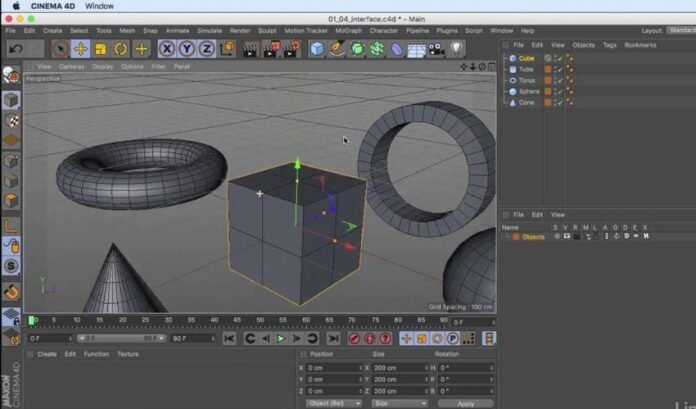Published on March 31, 2023 by Madeleine P.
Undoubtedly you are aware that in order to get a 3D printed part, the first step is having a 3D model. And though these can be downloaded off of platforms like Thingiverse, Yeggi, Printables, MyMiniFactory and more, often creating the model is necessary for parts that are customized or need to be tailored to certain characteristics. To do this, 3D modeling software is key. But with so many options available, choosing can often seem impossible. Today, we want to examine one of these many software solutions, Cinema 4D.
Cinema 4D is one of these 3D software suites offered by German company Maxon. Released in 1990, this professional 3D modeling, animation, simulation and rendering software solution is currently one of the most popular ones available today, compared to the likes of Blender, Maya and Autodesk 3ds Max. It is especially popular for motion graphic and game development and is known for being fast, powerful flexible and above all intuitive. However, what you might not know is that it can also be used to create models for 3D printing. We took a closer a look at the advantages of the software, as well as how you can use it for additive manufacturing.
Cinema 4D is well known for its ease of use
Using Cinema 4D For 3D Printing
Cinema 4D is a popular 3D modeling software for a number of reasons. Foremost among these is, of course, its ease of use. It is known to be one of the most intuitive software out there, with even beginners able to use its many features quickly and effectively. Moreover, it has a number of interesting features including a wide array of texturing tools, an expansive content browser, ZBrush integration and more. However, despite this, Cinema 4D is not one of the first software that may come to mind when you think of 3D printing. But that does not mean that it is not possible to use it, nor that it doesn’t have its own advantages for AM.
First, it is important to know is that STL files are natively supported by Cinema 4D. That means that files of this format can be easily imported or exported. Given that STL is one of the most 3D printing file formats, this will come in handy when you are making a 3D object on the platform. Do note, however, that other popular formats such as OBJ and 3MF are not available so, for 3D printing, you will need to use STL files.
Additionally, there are some design considerations to keep in mind. For example, you will want to ensure that you change the size settings and project scale to 1 millimeter and disable Phong Shading, which can be done by deleting the Phong tag. The latter especially is important because Cinema 4D automatically smooths parts using this, but in reality they are made of square polygons. This would definitely not be a benefit in terms of printing. Rather, users will need to adapt their model to make it smooth themselves, this can be done by increasing the number of segments in the model.
Being able to look inside your model is also important. 3D printers will not be able to understand objects that are merged together or connected and overlapping. One suggestion is to go into project settings and change the options for View Clipping. By increasing the setting and changing the zoom, you will have access to a cross-section view that will allow you to fix these mistakes before they go to the printer.
Incredible parts can be made for 3D printing in Cinema 4D as long as you adapt the software for your needs
Some final considerations? Ensure that your model is watertight. In modeling software that has been adapted for 3D printing specifically this is not necessarily an issue, but since Cinema 4D was not designed for this purpose it will not necessarily identify this for you. Luckily, by going enabling Mesh Check and Boundaring Edges in the Attribute Manger you will be able to see the holes in the mesh and thus fix them. Additionally, you need to ensure that every wall has a wall thickness. For Cinema 4D this is not always a given as it is commonly used for projects like animation where this does not need to be considered. However, a 3D printer will not be able to read your file without this information.
So overall it is absolutely possible to make 3D models for 3D printing for Cinema 4D as long as you keep these tips in mind. However, considering that Cinema 4D is a paid software, most 3D printing enthusiasts would be better suited to another software like Fusion 360 or FreeCAD. Still, if you are interested in using Cinema 4D for your 3D printing projects, you can find it HERE.
Do you use Cinema 4D for 3D printing? What do you think of it? Let us know in a comment below or on our LinkedIn, Facebook, and Twitter pages! Don’t forget to sign up for our free weekly Newsletter here, the latest 3D printing news straight to your inbox! You can also find all our videos on our YouTube channel.
*All Photo Credits: Cinema 4D
Post Disclaimer
The information provided in our posts or blogs are for educational and informative purposes only. We do not guarantee the accuracy, completeness or suitability of the information. We do not provide financial or investment advice. Readers should always seek professional advice before making any financial or investment decisions based on the information provided in our content. We will not be held responsible for any losses, damages or consequences that may arise from relying on the information provided in our content.



